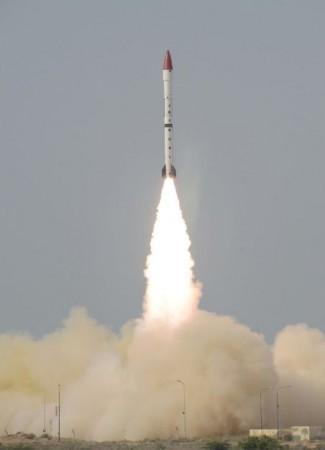
Pakistan announced on Tuesday that it has flight-tested a new nuclear-capable surface-to-surface ballistic missile, Ababeel, with a maximum range of 2,200km, according to a statement from its Army's media agency, Inter Services Public Relations (ISPR).
Read also: After Agni-V, India to test another nuke-capable ballistic missile, the K-4
The test was "aimed at validating various design and technical parameters of the weapon system," claimed ISPR statement.
It also has the capability to carry multiple warheads with the infamous Multiple Independent Re-entry Vehicle (MIRV) technology, something that will unnerve many South Asia watchers.
It further noted that the development of "Ababeel weapon system was aimed at ensuring survivability of Pakistan's ballistic missiles in the growing regional Ballistic Missile Defence (BMD) environment."
The flight test of the missile is considered a "landmark achievement" for Pakistani armed forces.
Pak successfully conducted first flight test of SSM #ABABEEL, Rg 2200 Km. #COAS congrats team and Pak Armed Forces for landmk achievement. pic.twitter.com/iXBGgJf9JN
— Maj Gen Asif Ghafoor (@OfficialDGISPR) January 24, 2017
Arms Race and Coming of the MIRVS in South Asia
Given the regularity in which Pakistan is testing new weapons- ballistic weapons or cruise, like Babur III that was recently fired from underwater platform empowering the country with a second strike capability.
The new missile, Ababeel, not only has the nuclear element but also the MIRV element, something India has not yet tested.
The test is bound to escalate the arms race in South Asia, which is already seeing a rise in missile tests. India recently tested Agni-IV and Agni-V. The country is also slated to test K-4- a submarine launched ballistic missile soon.
Though India does not currently have any operational MIRV in its inventory, it has been reported that India certainly has the capability for MIRV.
Reports on internet point towards India possibly including it in yet-to-be-developed Agni-VI missile. However the Defence Research and Development Organisation (DRDO) reportedly said that it is "validating technologies that will help India deploy MIRV on its missiles."
MIRV in a glimpse
US conceived MIRVs in 1960s as a counter to USSR during the Cold War. Soon, Russia had similar technology. But both the countries eventually signed several strategic agreements to reduce the number and weight of the warheads.
But in 2002, China successfully tested its first MIRV and over time bettered its delivery and number of warheads.
Will Ababeel missile render India BMD ineffective?
The new Pakistani missile has been designed to tackle Indian radars and its ambitious Ballistic Missile Defence (BMD) shield. India has a multi-layered BMD to shield itself from ballistic missile attacks.
In 2012, the then DRDO chief had said that India had initiated phase-I of the BMD. This included the capability to handle missiles with 2,000km targets. He had also claimed that the Phase-II to handle ballistic missiles with range of 5,000 km was expected to be ready by 2016.
Apart from this, India has also ordered 5 S-400 advanced air defence systems from Russia. This can provide defence from ballistic missiles of up to 3,500km range.
USA and China
When Pakistan launched the nuclear-capable Babur III missile, US had urged it to "exercise restraint regarding the use and testing of their nuclear capabilities" and encouraged it to "promote confidence building and stability with respect to those capabilities."
It will be interesting to see what the new Trump administration will have to say about the Pakistan's move.
Even more interesting would be the Chinese reaction. China had recently warned India to "maintain strategic balance in South Asia" when New Delhi tested Agni-V, an Inter Continental Ballistic Missile with over 5,000km range.
What does Ababeel even mean?
In the Quran, Ababeel are flock of birds sent by Allah against Abraha, the king of Yemen and Ethiopia who was attacking the Kaaba. The birds fiercely attacked Abraha and his army with stones that eventually killed the entire army.
#ABABEEL. CJCSC Gen Zubair Mahmood Hayat, CAS ACM Sohail Aman and CNS Adm Muhammad Zaka Ullah Congratulate team and Pakistan Armed Forces. pic.twitter.com/Bdz1LQxpJh
— Maj Gen Asif Ghafoor (@OfficialDGISPR) January 24, 2017

















